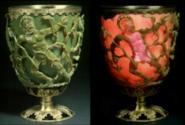It looks like you're using an Ad Blocker.
Please white-list or disable AboveTopSecret.com in your ad-blocking tool.
Thank you.
Some features of ATS will be disabled while you continue to use an ad-blocker.
5
share:
I honestly confess I had no clue what is Plasmon Resonance until I read this article and seems like ATS neither, when I typed that name on the search
engine.

A great tool for scientist I must say. So glad to see another invention based on an ancient culture knowledge.
engineering.illinois.edu...

Utilizing optical characteristics first demonstrated by the ancient Romans, researchers at the University of Illinois at Urbana-Champaign have created a novel, ultra-sensitive tool for chemical, DNA, and protein analysis.
A great tool for scientist I must say. So glad to see another invention based on an ancient culture knowledge.
The Lycurgus cup was created by the Romans in 400 A.D. Made of a dichroic glass, the famous cup exhibits different colors depending on whether or not light is passing through it; red when lit from behind and green when lit from in front. It is also the origin of inspiration for all contemporary nanoplasmonics research—the study of optical phenomena in the nanoscale vicinity of metal surfaces.
engineering.illinois.edu...
Very interesting I did not know about this cup. It's amazing the things our forefathers were capable of creating, without having any clue at all how
it worked. Stained glass windows are an example of nanotechnology at work.
reply to post by Trueman
Try just plasmon, or plasmonic, and you'll find me posting stuff for years.
It's a big new field.
Try just plasmon, or plasmonic, and you'll find me posting stuff for years.
It's a big new field.
reply to post by Trueman
I was just reading about this cup earlier and decided to do a quick search here for it
It really is amazing, and a stunning example!
pretty cool
here is a link for more info.
I was just reading about this cup earlier and decided to do a quick search here for it
It really is amazing, and a stunning example!
The ancient nanotech works something like this: When hit with light, electrons belonging to the metal flecks vibrate in ways that alter the color depending on the observer’s position. Gang Logan Liu, an engineer at the University of Illinois at Urbana-Champaign, who has long focused on using nanotechnology to diagnose disease, and his colleagues realized that this effect offered untapped potential. “The Romans knew how to make and use nanoparticles for beautiful art,” Liu says. “We wanted to see if this could have scientific applications.”
pretty cool
here is a link for more info.
edit on 26-8-2013
by Lady_Tuatha because: (no reason given)
Pretty cool for sure.
Although I don't understand why it was a roman cup that inspired him. Dichroic glass (sometimes simply called "dichro" in the lampworking world) has been used in glassware up until today. Hippies have been making "tobacco pipes" with dichro for years.
My point is, you think someone working with optics would be familiar with a common type of glass and not have to be inspired from a roman cup.
It's like saying I built my house from concrete because I was inspired by a concrete roman structure. It would be more accurate to say I built my house of concrete because it's known material that worked well for what I wanted.
Although I don't understand why it was a roman cup that inspired him. Dichroic glass (sometimes simply called "dichro" in the lampworking world) has been used in glassware up until today. Hippies have been making "tobacco pipes" with dichro for years.
My point is, you think someone working with optics would be familiar with a common type of glass and not have to be inspired from a roman cup.
It's like saying I built my house from concrete because I was inspired by a concrete roman structure. It would be more accurate to say I built my house of concrete because it's known material that worked well for what I wanted.
new topics
-
HORRIBLE !! Russian Soldier Drinking Own Urine To Survive In Battle
World War Three: 1 hours ago -
Bobiverse
Fantasy & Science Fiction: 3 hours ago -
Florida man's trip overseas ends in shock over $143,000 T-Mobile phone bill
Social Issues and Civil Unrest: 4 hours ago -
Former Labour minister Frank Field dies aged 81
People: 6 hours ago -
SETI chief says US has no evidence for alien technology. 'And we never have'
Aliens and UFOs: 7 hours ago -
This is our Story
General Entertainment: 10 hours ago
top topics
-
President BIDEN Vows to Make Americans Pay More Federal Taxes in 2025 - Political Suicide.
2024 Elections: 12 hours ago, 16 flags -
One Flame Throwing Robot Dog for Christmas Please!
Weaponry: 17 hours ago, 6 flags -
Florida man's trip overseas ends in shock over $143,000 T-Mobile phone bill
Social Issues and Civil Unrest: 4 hours ago, 6 flags -
SETI chief says US has no evidence for alien technology. 'And we never have'
Aliens and UFOs: 7 hours ago, 5 flags -
Don't take advantage of people just because it seems easy it will backfire
Rant: 17 hours ago, 4 flags -
Ditching physical money
History: 17 hours ago, 4 flags -
Former Labour minister Frank Field dies aged 81
People: 6 hours ago, 4 flags -
Bobiverse
Fantasy & Science Fiction: 3 hours ago, 3 flags -
This is our Story
General Entertainment: 10 hours ago, 3 flags -
Ode to Artemis
General Chit Chat: 13 hours ago, 3 flags
5
